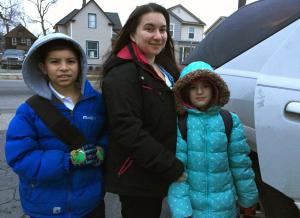Detroit Teachers Explain Why They’re ‘Sicking-Out’

Thousands of people have fled the Detroit public schools, but Alise Anaya decides every day to do the opposite, commuting from the suburbs to teach in one city school and drop her children off at another.
It's a surprising choice. Anaya grew up in Southwest Detroit, but many of the families she was raised alongside have left the city’s public schools in part because of conditions like those Anaya and hundreds of her colleagues have highlighted in a recent series of protests and sickouts — dead rodents, rotting floors and overcrowded classrooms.
The sickouts have shuttered dozens of schools on several days this month including on Jan. 20 – the day President Obama was in town – when 88 of the city’s 100 schools were closed. The teacher’s union took their complaints even further on Thursday, filing suit against the district to demand building repairs and the removal of the state-appointed emergency manager who runs the system.
The teacher’s frustrations reflect the alarming realities of a district struggling to survive after losing the bulk of its students. As Detroit's population has plummeted and its schools have faced new competition from suburban and charter schools, the city's public schools have gone from educating nearly 300,000 students in 1966 to just under 48,000 today. The district now carries an estimated $3.5 billion in debt.
And families are not the only ones leaving. Many of Detroit’s teachers have left, too, in search of better pay and cleaner, safer conditions in charter schools or the suburbs.
But Anaya, 32, is among those who’ve doubled down. Not only has she remained committed to the school system where she and her mother have both taught for years, she has chosen Detroit schools for her own kids, driving them in every morning from her home in suburban Allen Park.
Her son, Victor, 10 and daughter Analise, 8, attend the Academy of the Americas in Southwest Detroit, where classes are taught in both English and Spanish. Anaya teaches English as a Second Language at Clippert Academy, a middle school a few blocks away.
“My neighbors think I’m crazy,” she said of her decision to bypass a solid public school in Allen Park in favor of schools in a district that ranksdead last — or near the bottom — on most national measures. But Anaya said those statistics can obscure the caliber of teachers who remain committed.
“Because of all the cuts that have happened and so many teachers have left, the teachers that stay are really motivated. They really are staying out of the goodness of their hearts and they feel that this is where they need to be,” Anaya said. “Those are the kinds of people I want in front of my kids in the classroom.”
When teachers started calling in sick to protest deteriorating conditions in recent weeks, critics — including Emergency Manager Darnell Earley — accused them of harming children by depriving them of crucial learning time. The district has sought temporary restraining orders to block future sickouts. So far, judges have refused to grant the injunctions.
"Detroit Public Schools is a district that has been going through some very difficult financial challenges over the last number of years and we've worked very hard over the last year to get our internal house in order," said Michelle Zdrodowski, a spokesperson for the district. "We're getting resources into the classroom and school buildings. But while we do understand their frustrations, we don't agree with their method of voicing those frustrations. Students need to be school every day and to take a day of instruction away is not necessarily appropriate in our Detroit Teachers Explain Why They’re ‘Sicking-Out’ - Yahoo News:


